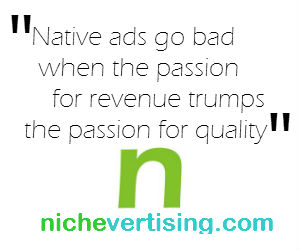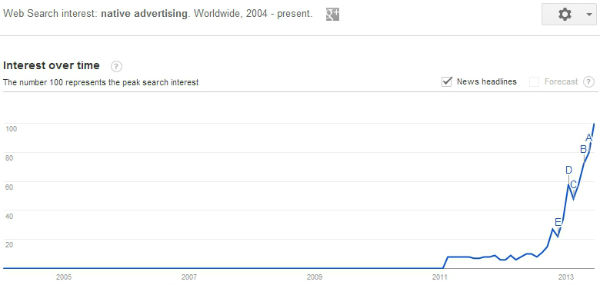 You can’t explain the “what is” of native advertising without explaining the good, the bad, and the ugly. Why is that? Simply because there’s so much bad and ugly.
You can’t explain the “what is” of native advertising without explaining the good, the bad, and the ugly. Why is that? Simply because there’s so much bad and ugly.
Native advertising is advertising at its best and worst. It’s what you would call controversial. Right now, it’s one of the main things making digital marketers look like ass hats. IMHO. But before we go there, let’s start with the good.
Native Advertising is Mostly Content Marketing
The first cousin of native advertising is content marketing. If you haven’t already, I suggest you read a post I published a few weeks ago breaking down the basics of content marketing strategy.
In that post, there is a graph with a Google Trends chart showing how the popularity of the term Content Marketing is currently exploding and that it’s just a tad off its all time high.
Here is that same graph from Google Trends for Native Advertising:
As you can see the popularity of the term Native Advertising is exploding just like the term Content Marketing. Unlike Content Marketing, the popularity of the term Native Advertising is currently at its absolute all time high.
One other thing to point out about the popularity of these two terms is that Content Marketing as a search term has been around since well before 2005. On the other hand, the term Native Advertising didn’t appear on the radar until many years later in 2011.
This makes sense, as Native Advertising is most often a subset of content marketing.
The Good of Native Advertising
Just like Content Marketing, Native Advertising is a marketing tactic used to create conversations around content instead of aggressively pushing someone down a sales conversion funnel.
This in itself is a good thing.
The main complaint advertising professionals get is that they interrupt people with content they don’t want. Native Advertising is specifically designed to solve this problem.
Instead of being an interruption, Native Advertising is designed to be the content of interest. Very similar to how Superbowl advertisements are just as much part of the game as the game itself.
When done well, the use of the term NATIVE becomes obvious.
For example, a good analogy is how you should plant grass that’s native to the environment where it must grow so that it require less nurturing from artificial sources to thrive. If you ignore the requirements of the environment, such as planting grass designed for the shade in a sunny area, it will die quickly unless many artificial resources are spent to nurture it.
The same effect is what happens with Native Advertising.
At one time, it was thought that banner advertisements were NATIVE to the internet. As it turns out, it often takes more than 1000 page views to get just one person to click on a banner ad. Comparing these results to what you get from real Native Advertising statistically, it’s is like needing to water your grass everyday for 6 hours when everyone else is watering their grass for 30 minutes.
Truly Native Advertisements are content elements like sponsored post on a blog (and now Facebook and Twitter) product placement in a video, and the search ads on Google’s search. In its essence, a Native ad is anything that looks 99% like the normal content you desire to consume. The 1% difference should be a disclosure that the content is a paid ad placement.
The Bad of Native Advertising
Native advertising starts to go bad when the content publisher does an insidious job of disguising the advertisements as real content to boost revenue.
There is a nice article on Digiday titled Native Advertising Is Bad News in which the author Ben Kunz breaks down Native Advertising into three buckets:
- The Frame
- The Insertion
- The Misdirection
Kunz does a nice job explaining each of these 3 types of Native Ads so I won’t regurgitate what you can and should go read yourself. However, I do want to add that all three of these forms of Native Ads can go from bad to worse when they get overdone.
For example, I am a big football fan. During the season, I used to be locked into ESPN starting at around 11:00 am every Sunday. Over the years, I have noticed that every segment on the show is starting to get “Brought to you by” something, someone, or somewhere.
It is very annoying to say the least! So much so that the last couple of seasons I tuned out ESPN as they now broadcast so many non-football related fluff story segments to fill their demand from advertisers.
Now, watching ESPN is even more of a waste of time than it used to be.
I come to ESPN to waste time watching sports not fluff stories “Brought to you by” that extremely annoying Progressive Insurance lady.
This is the fallacy of Native advertising. Native ads go bad when the passion for revenue trumps the passion for quality.
The Ugly of Native Advertising
I got two words and one website for you: BuzzFeed.com. This website is the ugly of Native Advertising.
BuzzFeed.com is more or less a Native Advertising network. The whole website is designed to create viral advertising disguised as organic content.
In order to do that, every cute animal video, every top 10 celebrity list, and every “it bleeds it leads story” you can think of is repackaged and published on BuzzFeed as a tool for Native Advertising.
To the chagrin of professional journalist and writers everywhere, it’s working. I notice unsuspecting Facebook friends everyday sharing annoying content from BuzzFeed not realizing they are sharing an advertisement.
Unsuspecting post such as the “25 Reasons Being A Kid Just Plain Sucks” “Brought to you by” Virgin Mobile with 544 Facebook shares.
Or “13 Things You Didn’t Know About Roller Derby” “Brought to you by” Miller 64 with over 2,000 Facebook shares…
If BuzzFeed’s model proves as sustainable, online news publishing could start getting real ugly. As they say, things will get worse before they get better.

